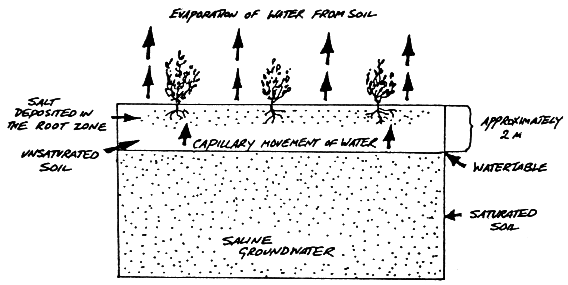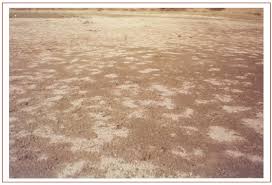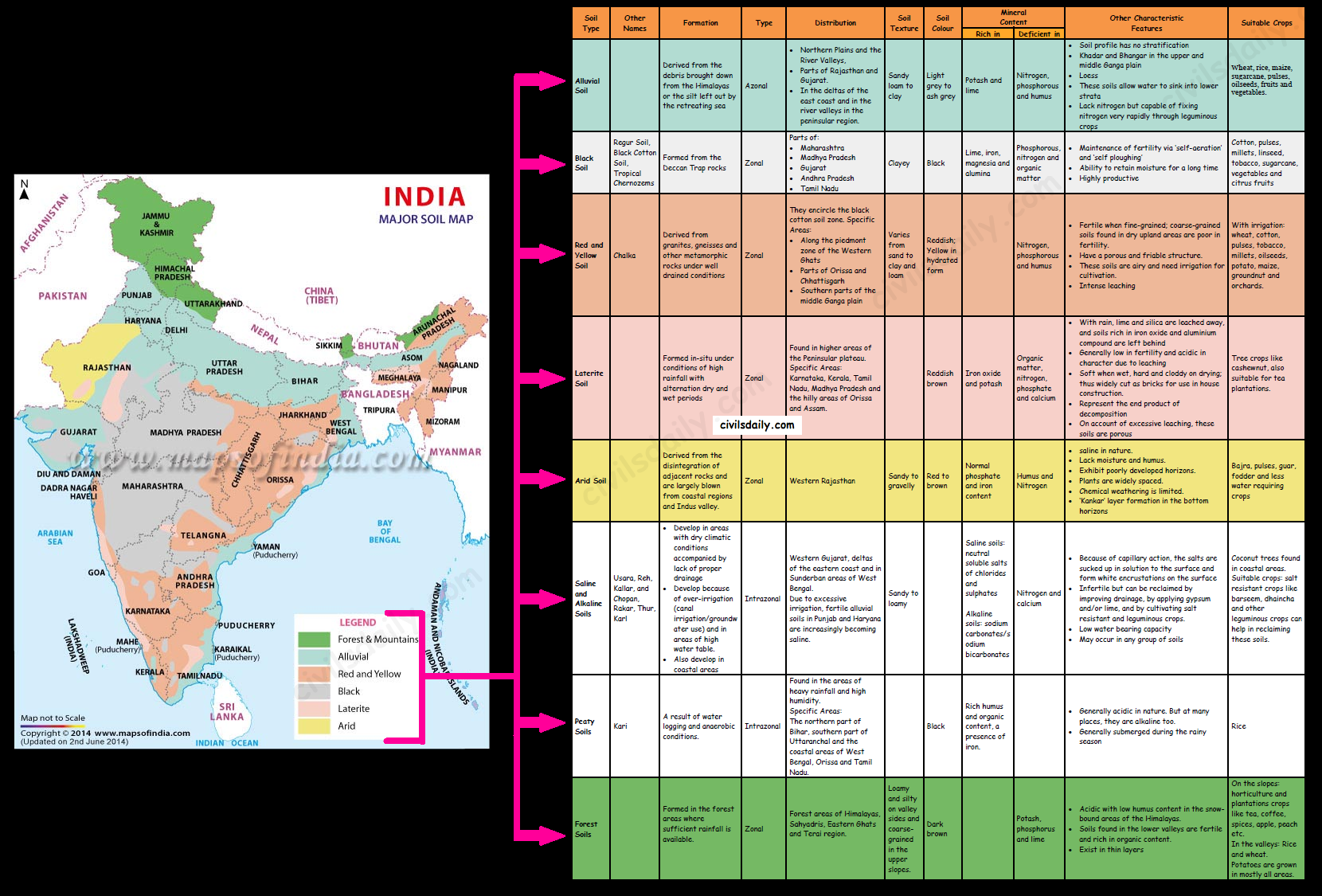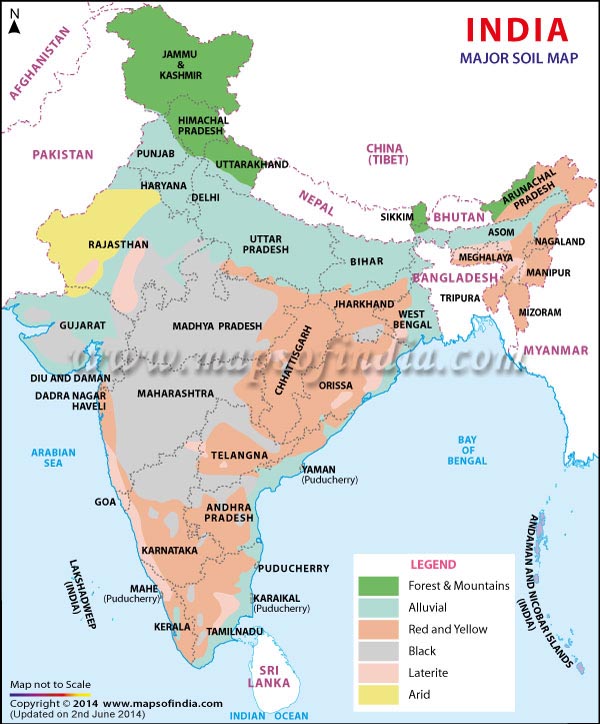We discussed in detail alluvial, black, red and laterite soils. Let’s continue the discussion and move on to the next soil types!
Source
5. Arid Soils
- Formation: These are derived from the disintegration of adjacent rocks and are largely blown from coastal regions and Indus valley.
- Areas: Arid soils are characteristically developed in western Rajasthan, which exhibit characteristic arid topography.
- Soil Colour: Arid soils range from red to brown in colour.
- Soil Texture: They are generally sandy to gravelly in texture and have a high percentage of soluble salts.
- Other characteristic features:
- These are saline in nature. In some areas, the salt content is so high that common salt is obtained by evaporating the saline water.
- Due to the dry climate, high temperature and accelerated evaporation, they lack moisture and humus.
- These soils are deficient in nitrogen and humus. The phosphate and iron content is normal. These soils are rich in minerals but the main limitation is the lack of water.
- The soils exhibit poorly developed horizons.
- Plants are widely spaced.
- Chemical weathering is limited.
- Lower horizons of the soil are occupied by ‘kankar’ layers because of the increasing calcium content downwards. The ‘Kankar’ layer formation in the bottom horizons restricts the infiltration of water, and as such when irrigation is made available, the soil moisture is readily available for a sustainable plant growth.
- Suitable crops: If irrigated these soils give high agricultural returns. The availability of water from the Indira Gandhi canal has transformed the agricultural landscape of desert soils of western Rajasthan. These soils are mainly devoted to bajra, pulses, guar, fodder and less water requiring crops.
6. Saline and Alkaline Soils
- They are also known as Usara soils. Various local names for saline soils are Reh, Kallar, and Chopan, Rakar, Thur, Karl etc.
- Formation:
- These soils have developed in areas with dry climatic conditions (in areas having a little more rainfall than the areas of desert soils) accompanied by lack of proper drainage. In this situation, salts of sodium, calcium and magnesium are deposited on the upper layer of the soil by capillary action.

Source
- In the Rann of Kuchchh, the Southwest Monsoon brings salt particles and deposits there as a crust.
- These soils are also formed when saline water spreads on the land at the time of high tide in coastal areas. Also, seawater intrusions in the deltas promote the occurrence of saline soils.
- Salinization also occurs because of over-irrigation (canal irrigation/groundwater use) and in areas of high water table (as in the coastal areas of Maharashtra and Tamil Nadu).Salinity from irrigation can occur over time wherever irrigation occurs. This is because almost all water (even natural rainfall) contains some dissolved salts. When the plants use the water, the salts are left behind in the soil and eventually begin to accumulate. Also, excessive irrigation with dry climatic conditions promotes capillary action, which results in the deposition of salt on the top layer of the soil (See the following figure).

Source
- These are thus, intrazonal soils.
- These soils have developed in areas with dry climatic conditions (in areas having a little more rainfall than the areas of desert soils) accompanied by lack of proper drainage. In this situation, salts of sodium, calcium and magnesium are deposited on the upper layer of the soil by capillary action.
- Areas: They occur in arid and semi-arid regions, and in waterlogged and swampy areas. These are more widespread in western Gujarat, deltas of the eastern coast and in Sunderban areas of West Bengal.
- Soil Texture: Their texture ranges from sandy to loamy.
- Other characteristic features:
- Because of capillary action, the salts are sucked up in solution to the surface and form white encrustations on the surface (See the picture below).

Source
- The salt efflorescence of calcium, magnesium and sodium makes these soils infertile.
- Saline soils contain an excess of neutral soluble salts of chlorides and sulphates whereas sodic or alkali soils contain sodium carbonates/ sodium bicarbonates.
- They lack in nitrogen and calcium and have low water bearing capacity.
- These soils can be reclaimed by improving drainage, by applying gypsum and/or lime, and by cultivating salt resistant crops like barseem, dhaincha and other leguminous crops.
- The saline and alkaline soils may occur in any group of soils.
- Because of capillary action, the salts are sucked up in solution to the surface and form white encrustations on the surface (See the picture below).
- Crops grown: In coastal areas, coconut trees are found in plenty in these soils. As discussed above, cultivating salt resistant crops like barseem, dhaincha and other leguminous crops can help in reclaiming these soils.
- Note: In the areas of intensive cultivation with excessive use of irrigation, especially in areas of green revolution, the fertile alluvial soils are becoming saline. In such areas, especially in Punjab and Haryana, farmers are advised to add gypsum to solve the problem of salinity in the soil.
7. Peaty Soils
- These soils are locally called Kari in Kottayam and Alleppey districts of Kerala.
- Formation: These are marshy soils and are a result of water logging and anaerobic conditions (which leads to partial decomposition of organic matter).
- Areas: They are found in the areas of heavy rainfall and high humidity, where there is a good growth of vegetation. It occurs widely in the northern part of Bihar, the southern part of Uttaranchal and the coastal areas of West Bengal, Orissa and Tamil Nadu.
- Soil Colour and Texture: These soils are normally heavy and black in colour
- Other characteristic features:
- These soils are characterised by a rich humus and organic content.
- There is a presence of iron and varying amounts of organic matter (10-40%). The organic matter in these soils may go even up to 40-50 per cent.
- These soils are generally acidic in nature. But at many places, they are alkaline also.
- Suitable crops: These are generally submerged during the rainy season and utilised for the cultivation of rice.
8. Forest Soils
- Formation: As the name suggests, forest soils are formed in the forest areas where sufficient rainfall is available.
- Areas: These are found in the forest areas of Himalayas, Sahyadris, Eastern Ghats and terai region.
- Soil colour and texture: The soils vary in structure and texture depending on the mountain environment where they are formed. They are loamy and silty on valley sides and coarse-grained in the upper slopes. Their colour is dark brown.
- Other Characteristics:
- In the snow-bound areas of the Himalayas, they are acidic with low humus content. This is because humus is rawer at higher levels. Also, these soils are subjected to denudation due to landslides and snowfall.
- The soils found in the lower valleys are fertile and rich in organic content.
- Owing to sharp differences of hill slopes and climates, these soils may differ greatly even when in proximity. [Recall here the discussion on the impact of topography on soils!]
- Also, these soils exist in thin layers because of their development on the mountain slopes.
- These soils are poor in potash, phosphorus and lime.
- Soil erosion is a major problem in these areas.
- Crops grown: The slopes are used for horticulture and plantations crops like tea, coffee, spices, apple, peach etc. Rice and wheat are grown in valleys. Potatoes are grown in mostly all areas.
Now that we are done with all the soil types, expand the following image for a quick revision!



Great.. Love you Civilsdaily..